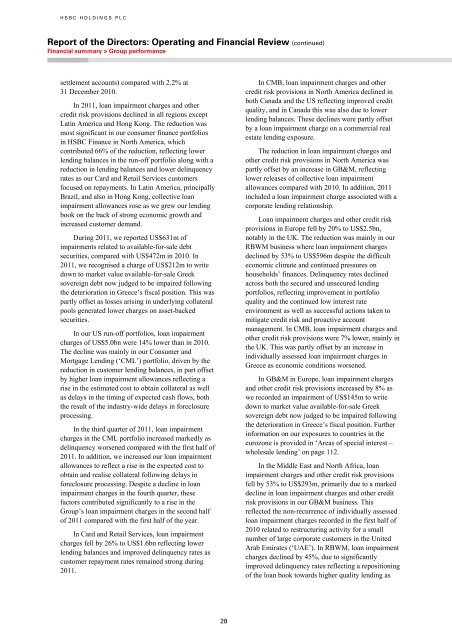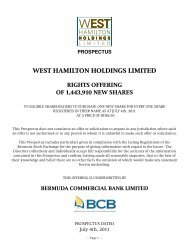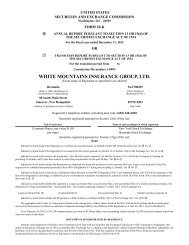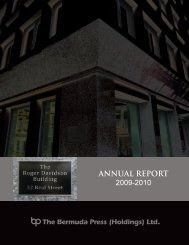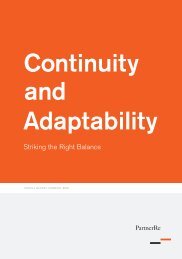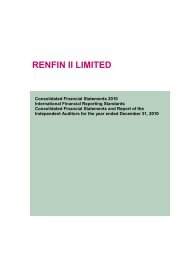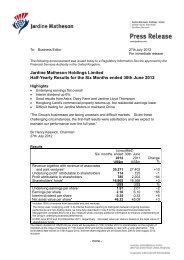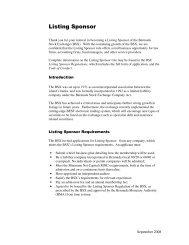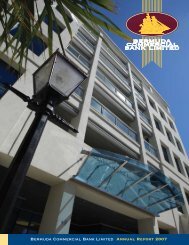Annual Report and Accounts 2011 - Bermuda Stock Exchange
Annual Report and Accounts 2011 - Bermuda Stock Exchange
Annual Report and Accounts 2011 - Bermuda Stock Exchange
You also want an ePaper? Increase the reach of your titles
YUMPU automatically turns print PDFs into web optimized ePapers that Google loves.
HSBC HOLDINGS PLC<br />
<strong>Report</strong> of the Directors: Operating <strong>and</strong> Financial Review (continued)<br />
Financial summary > Group performance<br />
settlement accounts) compared with 2.2% at<br />
31 December 2010.<br />
In <strong>2011</strong>, loan impairment charges <strong>and</strong> other<br />
credit risk provisions declined in all regions except<br />
Latin America <strong>and</strong> Hong Kong. The reduction was<br />
most significant in our consumer finance portfolios<br />
in HSBC Finance in North America, which<br />
contributed 66% of the reduction, reflecting lower<br />
lending balances in the run-off portfolio along with a<br />
reduction in lending balances <strong>and</strong> lower delinquency<br />
rates as our Card <strong>and</strong> Retail Services customers<br />
focused on repayments. In Latin America, principally<br />
Brazil, <strong>and</strong> also in Hong Kong, collective loan<br />
impairment allowances rose as we grew our lending<br />
book on the back of strong economic growth <strong>and</strong><br />
increased customer dem<strong>and</strong>.<br />
During <strong>2011</strong>, we reported US$631m of<br />
impairments related to available-for-sale debt<br />
securities, compared with US$472m in 2010. In<br />
<strong>2011</strong>, we recognised a charge of US$212m to write<br />
down to market value available-for-sale Greek<br />
sovereign debt now judged to be impaired following<br />
the deterioration in Greece’s fiscal position. This was<br />
partly offset as losses arising in underlying collateral<br />
pools generated lower charges on asset-backed<br />
securities.<br />
In our US run-off portfolios, loan impairment<br />
charges of US$5.0bn were 14% lower than in 2010.<br />
The decline was mainly in our Consumer <strong>and</strong><br />
Mortgage Lending (‘CML’) portfolio, driven by the<br />
reduction in customer lending balances, in part offset<br />
by higher loan impairment allowances reflecting a<br />
rise in the estimated cost to obtain collateral as well<br />
as delays in the timing of expected cash flows, both<br />
the result of the industry-wide delays in foreclosure<br />
processing.<br />
In the third quarter of <strong>2011</strong>, loan impairment<br />
charges in the CML portfolio increased markedly as<br />
delinquency worsened compared with the first half of<br />
<strong>2011</strong>. In addition, we increased our loan impairment<br />
allowances to reflect a rise in the expected cost to<br />
obtain <strong>and</strong> realise collateral following delays in<br />
foreclosure processing. Despite a decline in loan<br />
impairment charges in the fourth quarter, these<br />
factors contributed significantly to a rise in the<br />
Group’s loan impairment charges in the second half<br />
of <strong>2011</strong> compared with the first half of the year.<br />
In Card <strong>and</strong> Retail Services, loan impairment<br />
charges fell by 26% to US$1.6bn reflecting lower<br />
lending balances <strong>and</strong> improved delinquency rates as<br />
customer repayment rates remained strong during<br />
<strong>2011</strong>.<br />
In CMB, loan impairment charges <strong>and</strong> other<br />
credit risk provisions in North America declined in<br />
both Canada <strong>and</strong> the US reflecting improved credit<br />
quality, <strong>and</strong> in Canada this was also due to lower<br />
lending balances. These declines were partly offset<br />
by a loan impairment charge on a commercial real<br />
estate lending exposure.<br />
The reduction in loan impairment charges <strong>and</strong><br />
other credit risk provisions in North America was<br />
partly offset by an increase in GB&M, reflecting<br />
lower releases of collective loan impairment<br />
allowances compared with 2010. In addition, <strong>2011</strong><br />
included a loan impairment charge associated with a<br />
corporate lending relationship.<br />
Loan impairment charges <strong>and</strong> other credit risk<br />
provisions in Europe fell by 20% to US$2.5bn,<br />
notably in the UK. The reduction was mainly in our<br />
RBWM business where loan impairment charges<br />
declined by 53% to US$596m despite the difficult<br />
economic climate <strong>and</strong> continued pressures on<br />
households’ finances. Delinquency rates declined<br />
across both the secured <strong>and</strong> unsecured lending<br />
portfolios, reflecting improvement in portfolio<br />
quality <strong>and</strong> the continued low interest rate<br />
environment as well as successful actions taken to<br />
mitigate credit risk <strong>and</strong> proactive account<br />
management. In CMB, loan impairment charges <strong>and</strong><br />
other credit risk provisions were 7% lower, mainly in<br />
the UK. This was partly offset by an increase in<br />
individually assessed loan impairment charges in<br />
Greece as economic conditions worsened.<br />
In GB&M in Europe, loan impairment charges<br />
<strong>and</strong> other credit risk provisions increased by 8% as<br />
we recorded an impairment of US$145m to write<br />
down to market value available-for-sale Greek<br />
sovereign debt now judged to be impaired following<br />
the deterioration in Greece’s fiscal position. Further<br />
information on our exposures to countries in the<br />
eurozone is provided in ‘Areas of special interest –<br />
wholesale lending’ on page 112.<br />
In the Middle East <strong>and</strong> North Africa, loan<br />
impairment charges <strong>and</strong> other credit risk provisions<br />
fell by 53% to US$293m, primarily due to a marked<br />
decline in loan impairment charges <strong>and</strong> other credit<br />
risk provisions in our GB&M business. This<br />
reflected the non-recurrence of individually assessed<br />
loan impairment charges recorded in the first half of<br />
2010 related to restructuring activity for a small<br />
number of large corporate customers in the United<br />
Arab Emirates (‘UAE’). In RBWM, loan impairment<br />
charges declined by 45%, due to significantly<br />
improved delinquency rates reflecting a repositioning<br />
of the loan book towards higher quality lending as<br />
28


